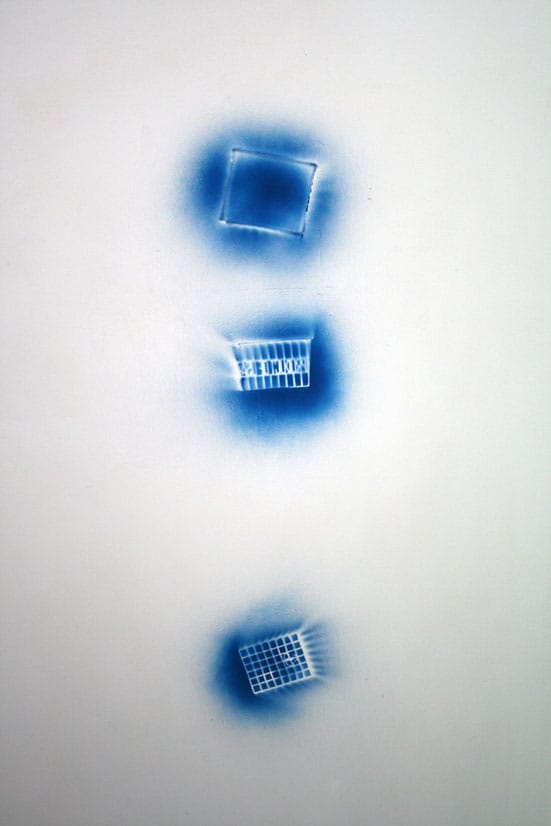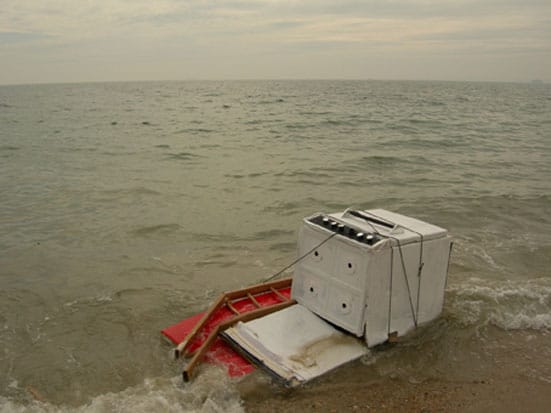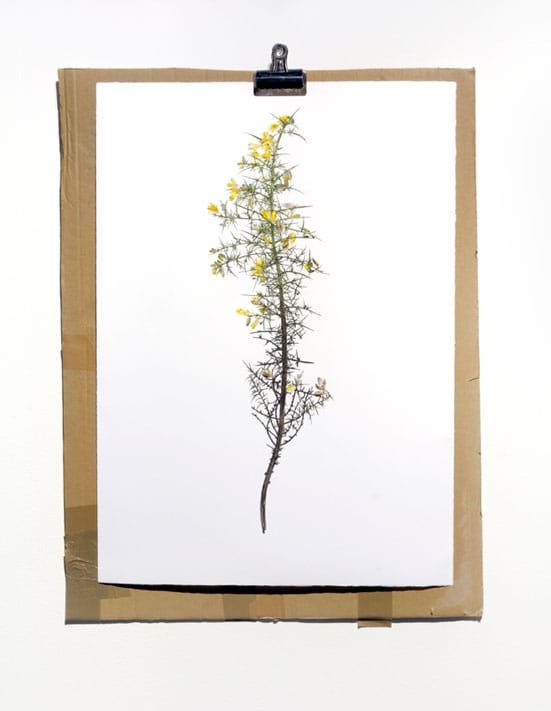Andy Parker’s work touches centrally on the role and function of objects within art, challenging the commodity status of the art work, while exploring the legacies of the ready-made and Conceptual art.
In the series Rafts, 2007, Parker engages with issues of value, function, production and decay. He builds ephemeral and unstable constructions of cardboard, tape, string, paint and tin-foil that replicate household objects such as washing machines, microwaves, refrigerators and mattresses, at a point of obsolescence. These works seem to deliberately expose their own process of production, with a rough finish to them that connects with a tradition of sculpture that was based on the accumulation of obsolete objects and detritus. The materials and procedures he uses in these particular works are impoverished and have a sense of DIY aesthetic. They are taken from what Benjamin Buchloh once referred to as ‘the reverse of consumer culture’, the containers and wrapping materials in which items are packed and shipped.
Together with these constructions or simulations, Parker has also engaged in the production of a series of botanical drawings Ulex europaeus, 2008, which draws attention to notions of repetition and imitation and to the value of a thing once it has stopped serving a function. These notions also transpire in one of his recent works, Lighting & Electrical, 2009, where he replicated a display of light bulbs from a hardware shop.
Rafts originate in the household objects that people dump across the city. Objects that have already served a purpose and that no longer have a function. Now that objects are so rapidly replaced, what is so attractive about these discarded objects and about replicating them?
Andy Parker: The household objects on my rafts are intentionally generic. Rather than being 'this fridge' or 'that cooker', I use simulation to create a more propositional object. Unlike the readymade, which embodies the intentionality of other people, these objects exist only through the intention of making an artwork. By constructing a washing machine out of old boxes I render a useful object un-useful. In a sense this means that its moment of usefulness lies somewhere within that performance of the work, that performance of creation, which is perhaps why I am so keen that they should be destroyed.
These simulations are cast into the sea and then you photograph or record them as they drift and flounder along the coastline. There is a sense of ritual in this process from their construction to their completion, which is at the same time their own destruction. Could you talk a bit about this cyclical process?
AP: The destruction of work originated from studying minimal and early conceptual work - somewhere nestled amongst the work of Michael Asher I should think. When I studied painting I was concerned with the impact of context on the work I was producing, so I began to work site-specifically, beginning with wall drawings and moving into sculptural interventions. The subsequent necessary destruction of this work modified its meaning, and was heightened by the labour inherent in its production. I've been keen to get away from the simple tension in seeing great labour set up to be destroyed – it’s too quick and self-referential. My desire is more that this fluctuating application of labour in production is just part of a cyclical thing, in that things get made, more or less well, and things get destroyed, more or less completely.
In your work, there is a strong performative element in the way in which you consciously incorporate to it the process of construction and its consecutive destruction, as if to draw attention to the physical labour involve in making the work. Why is it important to expose these processes?
AP: The cardboard objects I make are human scale. The card is roughly handled and I don't attempt to disguise the fact that the objects are built from old boxes and painted with household paint. Where possible I use boxes from household appliances as they are the right size; my use of labour is not intended to be perverse. I try to share a physical understanding of objects by exposing the materials and processes used, as well as the activity brought it together. Each piece points to a performance of construction or mark making that is in some cases slight, in others excessive, but always tries for the appearance of general skilled labour over the language of individualised innate talent. Similarly, if I were present as performer, the work would point specifically to a unique creator, and that’s just not interesting to me. At the moment.
In the series of drawings Ulex europaeus there is another kind of laborious process, perhaps not as physical but certainly the drawings in these series demand a great level of attention and detail that marks a stark contrast with Rafts. Can you talk a bit about this work?
AP: Ulex europaeus is the Latin classification for Furze or Gorse, a plant familiar in the British Landscape. Historically it’s been useful, planted around the world by European colonies for use in agricultural and construction. Long after its usefulness had been superseded it continues to spread, threatening native plants and habitats bordering the Atlantic and Pacific coasts. After visiting one of these threatened habitats I became interested in the persistence of this natural asset turned noxious weed. I gathered my first samples from the A3 in Hindhead, where they were clearing Furze to make way for an underpass.
It was important for these works that my hand became skilled enough to produce a painting on the same terms as other botanical studies; by sticking within the boundaries of this genre the paintings remain strictly observational. It wasn't about following the usual logic of botanical works, where you might be recording samples from a range of different plants for scientific comparison, or for aesthetic pleasure. I had a desire to make something within the realms of useful art, but then to go on producing and producing them, each time starting from square one with a fresh specimen, and each time covering the same ground without any sense of ending.
Much of your work is related to imitation and repetition; could you talk a bit about the value of these notions?
AP: To produce objects in a repetitive manner implies that they have a use, but foreground a lack of expressive meaning. Seeing Rauschenberg's Factum I and II displayed together was really important as it brought the threat of this meaningless, excessive production, into my understanding of Painting. Although touching on similar issues, it seemed the opposite of the readymade, where the mass-produced object is rendered meaningful by re-contextualization as Art.
The same could be said of your recent work Lighting & Electrical 2009, could you explain a bit on how it originated?
AP: Lighting & Electrical followed from an initial attraction to a display of light bulbs in a small hardware store. Under the pretext of providing illumination, it showed an array of bulbs of various shapes and sizes that opened up a world of choice. The display itself was wonderfully spare - an 8ft piece of wood with light bulb holders screwed in at almost regular intervals dangling from two chains in the ceiling. At some stage the bulbs on display had begun to fail, some were replaced, others removed or left unworking. What remained was an object invented through need to show a choice from an abundance of options. As that abundance had run short, the invented object was rendered obsolete and pointed back to its origins of catering to our need for light. When I remade the object as Lighting & Electrical there was no invention involved - it is a straight copy made from things on sale in that shop. Like the original it is displayed in already lit rooms that have no need for the cacophony of illumination on offer.
In your work there seems to be a preoccupation with what happens to a thing when it becomes useless. This often results in a tension between functional object and aesthetic object; can you talk a bit more about this?
AP: It emanates from a way of seeing objects and establishing meaning. There is something in the way certain virtues are given to things – dependable tools, efficient appliances, powerful cars. A kind of metaphor and emotion hides functional objects amongst attributes we would ascribe to people. The uselessness of obsolescence removes that burden, exposing things more visibly as physical objects held at the point they let us down. So you are right, my interest in this kind of uselessness is focused at a point between functional objects and art objects. That gap is very resistant to being contained or consumed.
The objects you produce are representative of different social spaces, mostly domestic spaces, what draws you these particular spaces?
AP: Domestic space is familiar to us all in one way or another and I find this familiarity to be very rich. What our homes offer usually exceeds our basic needs, impacting negatively on the space and resources we all share. I recently saw Herman Asselberghs, Dear Steve (2010). It's a video of a chap dismantling a Powerbook whilst a voiceover explains the various sources and consequent impact inherent in its production, use and disposal. What emerges from this work was how the two 'messy' parts of that process occur elsewhere, away from 'home'. What the far away suppliers and disposal facilities deal with are noxious piles of components and chemicals, whilst what arrives for the consumer is a compact, sleek, functional product. There is an enormous, disquieting, gothic, backdrop lurking behind the discreet objects and spaces of comfortable daily experience.
And is this also something you are dealing with in your current work Souvenir of L.A.?
AP: Souvenir of LA continues my interest in multiple objects in that the focus is a mass produced plastic basket that held a portion of strawberries. Part of its structure is cleverly formed by the words PRODUCT OF USA which reads in reverse in the work as bright blue paint is sprayed through its stencil –like form, onto the wall. It’s important that I spray the paint, as it’s my souvenir, but beyond that I haven’t added any other terms to the work, so it is as permanent or temporary as its locations allow. What is probably crucial is the performativity of the word ‘Souvenir’ from the title, which leaks into other words used to describe our things, like the word ‘historical’.
Now that I think of it, perhaps this relationship of word, performance and objects feeds back into all the other things you were asking about. Maybe it’s all souvenirs of sorts?
Carmen Julia

Andy Parker
Souvenir of LA
Spraypaint on wall
Dimensions Variable
2010

Andy Parker
Documentation at Spithead
Cardboard, tape, paint
2.2 x 1 x 2.8 m
2006

Andy Parker
Ulex europaeus iv
watercolour painting, cardboard, bulldog clip
50 x 85 cm
2008